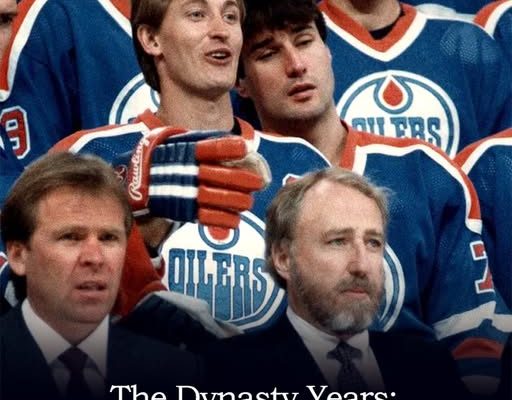The 1980s Edmonton Oilers were more than just a successful hockey team—they were a seismic shift in the way the game was played, viewed, and understood. They didn’t merely win; they transformed. What they built in that decade wasn’t just a dynasty but a living, breathing spectacle of offensive prowess, dazzling speed, and unrelenting innovation. Prior to their rise, the National Hockey League was largely dominated by physicality, structured defensive systems, and a grinding style of play that valued brute strength over finesse. Then came a group of fearless young men from Edmonton who turned the sport on its head and redefined what excellence looked like on ice.
The story of the Edmonton Oilers in the 1980s begins with their emergence from the World Hockey Association and entry into the NHL in 1979. They were newcomers, seen as long shots to make any significant impact in a league dominated by legendary franchises like the Montreal Canadiens and the New York Islanders. But what set the Oilers apart immediately was the presence of a transcendent talent—a skinny, unassuming teenager named Wayne Gretzky. Dubbed “The Great One,” Gretzky would go on to change the game forever, and Edmonton was the canvas on which his artistry first flourished.
Gretzky’s vision, hockey IQ, and passing ability were unlike anything the league had seen before. He could anticipate plays seconds before they unfolded and find teammates in positions that defied defensive structure. But it wasn’t just Gretzky’s brilliance that powered the Oilers’ revolution—it was the cast of elite talent assembled around him that transformed the team into an unstoppable force. Players like Mark Messier, whose fierce leadership and rugged style anchored the forward group; Paul Coffey, who redefined what it meant to be an offensive defenseman; and Jari Kurri, the perfect finishing complement to Gretzky’s setups. Each of these players brought something unique to the ice, and together, they created a synergy that overwhelmed opponents night after night.
What made the Oilers so revolutionary wasn’t just their talent—it was how they used it. Head coach Glen Sather recognized early that this team wasn’t going to win by playing traditional hockey. Instead, he gave his stars the freedom to express themselves on the ice. Rather than tightening the reins, he loosened them, encouraging creativity, risk-taking, and a relentless offensive mindset. The result was a brand of hockey that was electrifying to watch and nearly impossible to defend.
The Oilers didn’t just outscore teams; they demoralized them. During their peak years, Edmonton regularly led the league in goals scored, setting records that still stand today. In the 1983-84 season alone, they scored a jaw-dropping 446 goals, averaging over five per game. Gretzky tallied 205 points that season—an unimaginable number by modern standards. Coffey would contribute over 120 points from the blue line, while Kurri and Messier racked up goals at an astonishing pace. The Oilers didn’t merely aim to win—they aimed to dominate.
Their first taste of Stanley Cup glory came in 1984, after years of falling short against the dynastic New York Islanders. But this time, the Oilers were ready. They dethroned the reigning champions in five games, ending the Islanders’ four-year reign and signaling the dawn of a new era. This victory was more than just a title—it was a passing of the torch. The Oilers would go on to win four more Stanley Cups in 1985, 1987, 1988, and 1990, cementing their place as one of the greatest dynasties in sports history.
But their influence extended far beyond the hardware. The Oilers changed how the NHL viewed team construction. Their model emphasized drafting and developing elite talent, giving young stars the room to grow, and prioritizing speed and skill over sheer size. Teams began to emulate their blueprint, drafting more agile, skilled players and crafting systems that emphasized transition play and offensive creativity. The ripple effects of the Oilers’ success are still felt today, as modern NHL teams strive to balance structure with the kind of offensive explosiveness Edmonton embodied.
Perhaps even more importantly, the Oilers made hockey fun. They turned the game into a spectacle, a high-flying performance that thrilled fans and brought new eyes to the sport. Their games were must-watch events, not just in Edmonton but across Canada and eventually the United States. As Gretzky’s star grew, so too did the NHL’s footprint, especially in American markets that had previously shown little interest in the sport. It’s no exaggeration to say that the 1980s Oilers helped pave the way for the league’s expansion into cities like San Jose, Tampa Bay, and Nashville. Gretzky’s eventual trade to the Los Angeles Kings in 1988—though devastating to Edmonton fans—only further accelerated this growth, turning him into a global ambassador for the game.
The Oilers also redefined team culture. Despite the individual brilliance of so many players, there was a selflessness and unity to the way they played. Each superstar was willing to play their role, make sacrifices, and contribute to the collective success of the team. Whether it was Gretzky deferring to a hot-handed Kurri, or Messier stepping up as the emotional leader during tough playoff battles, the Oilers operated with a rare harmony that made them not just a team, but a brotherhood.
Off the ice, the Oilers became cultural icons. Their personalities were as magnetic as their play. Gretzky’s quiet humility, Messier’s fiery competitiveness, Coffey’s laid-back confidence, and Kurri’s international charm made them household names. They were heroes to a generation of fans who saw in them not just athletes, but embodiments of what was possible when talent met trust, and creativity met courage.
The 1990 Stanley Cup win, coming after Gretzky’s departure, was a final statement that the culture and greatness built in Edmonton transcended any one player. It was a crowning achievement that validated the entire organization—from Sather’s vision, to the development pipeline, to the leadership within the locker room. That fifth title was both a climax and a coda to one of the most exhilarating chapters in hockey history.
In the years since, the legend of the 1980s Oilers has only grown. Their highlights still circulate widely, their records are still revered, and their impact is still cited by coaches, players, and analysts alike. Modern stars like Connor McDavid—ironically also an Edmonton Oiler—have drawn comparisons to Gretzky, continuing the franchise’s legacy of generational brilliance. But even in today’s game, with its blazing speed and intricate systems, the influence of the 1980s Oilers is unmistakable. Every tape-to-tape pass through the neutral zone, every rush that ends in a backdoor finish, every offensive scheme that prioritizes puck movement and player freedom—they all trace their roots back to what Edmonton pioneered four decades ago.
The Oilers weren’t just a product of their time—they were ahead of it. They anticipated the direction hockey was heading and then bent the game to their will. They proved that speed and finesse could beat toughness and tradition. They demonstrated that giving players creative license could lead to historic success. And they showed that even in a team sport, individual brilliance could flourish without sacrificing collective goals.
To understand the evolution of hockey, one must understand the 1980s Edmonton Oilers. They were artists in skates, architects of a new era, and symbols of what happens when vision meets execution. Their journey from a WHA afterthought to a five-time Stanley Cup-winning juggernaut is the stuff of legend, but their true legacy lies in the game itself—how it’s played, how it’s loved, and how it continues to grow.
In the end, the Oilers of the 1980s didn’t just win hockey games—they won hearts, minds, and imaginations. They elevated a sport, empowered a generation, and etched themselves into the pantheon of athletic greatness. Their names will forever echo through the halls of NHL history, not just as champions, but as revolutionaries who changed the very soul of the game.



